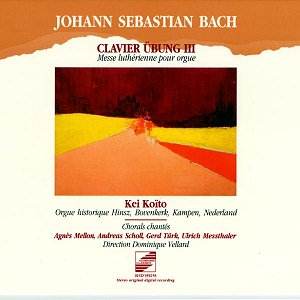 Composer: Johann Sebastian Bach
Composer: Johann Sebastian Bach
Works: Clavier Übung III, Lutheran Mass for Organ
Performers: Kei Koïto, organ; Agnès Mellon, Andreas Scholl, Gerd Türk, Ulrich Messthaler, vocals
Recording: May 1994, St. Nicholas of Bovenker, Kampen, Netherlands
Label: Harmonic H/CD 9352-53
Johann Sebastian Bach’s Lutheran Mass for Organ, a significant compendium within his oeuvre, serves both as a pedagogical tool for organists and a profound exploration of liturgical music. First published in 1739, this work is a rich tapestry of preludes and chorales, each intricately woven with theological depth and musical ingenuity. Bach crafted this collection not merely for performance but as a resource for organists to curate their own liturgical experiences, allowing for a flexible interplay between large and smaller organs, as indicated by his meticulous markings of manualiter.
Kei Koïto’s interpretation of this monumental work is marked by a keen sensitivity to Bach’s intentions. The recording opens with the grand Prelude in E-flat major, BWV 552, a piece that encapsulates the very essence of Bach’s contrapuntal mastery. Koïto’s execution is commendable; her touch is both assertive and nuanced, steering clear of the temptation to overemphasize the work’s dramatic climaxes. Instead, she maintains a balance that allows the intricate fugal lines to unfold organically, culminating in a fugue that is as exhilarating as it is controlled. This delicate equilibrium is a hallmark of her performance, which consistently showcases a refined sense of registration that enhances the clarity of each voice within the polyphonic texture.
The chorales, sung by a quartet of voices, add an enriching layer to the experience. This choice to intersperse the organ works with vocal renditions mirrors the communal aspect of worship during Bach’s era, allowing listeners to appreciate the original hymnic context of these pieces. For instance, in Chorale BWV 674, Koïto’s registration choices illuminate the fugal intricacies while the vocalists’ harmonies provide a resonant backdrop that enhances the overall soundscape. The SATB arrangement offers a fuller, more sonorous interpretation compared to other recordings, such as Jean-Charles Ablitzer’s Orgelbüchlein, where a solo tenor’s voice might feel somewhat stark. This quartet configuration beautifully reflects the inherent richness of Bach’s choral writing, offering listeners a vivid connection to the congregation’s experience during the Mass.
The recording quality deserves particular commendation. Captured in the acoustically favorable environment of St. Nicholas of Bovenker, the sound engineering achieves remarkable clarity, allowing the subtleties of Koïto’s nuanced playing to resonate without being overshadowed by the organ’s natural power. The balance between organ and voice is expertly managed, ensuring that neither overwhelms the other, which is critical for a work that thrives on the interplay of these elements.
Koïto’s interpretative choices resonate with an understanding of historical performance practices, yet she imbues the music with a contemporary freshness. Her approach to the delicate passages, particularly in Chorale BWV 675, demonstrates an artistic maturity that brings the pastoral qualities of Bach’s writing to the fore. The careful articulation and dynamic shading she employs allow each phrase to breathe, thereby inviting listeners into an intimate dialogue with the music.
This recording stands out as a significant addition to the discography of Bach’s organ works. With Koïto’s insightful interpretations and the complementary choral elements, the album not only serves as an exemplary model for organists but also provides a rich listening experience for enthusiasts of Bach’s sacred music. The unique combination of organ and voice encapsulates the spirit of the Lutheran tradition, making this a compelling and satisfying interpretation of a foundational work in the Western canon.



